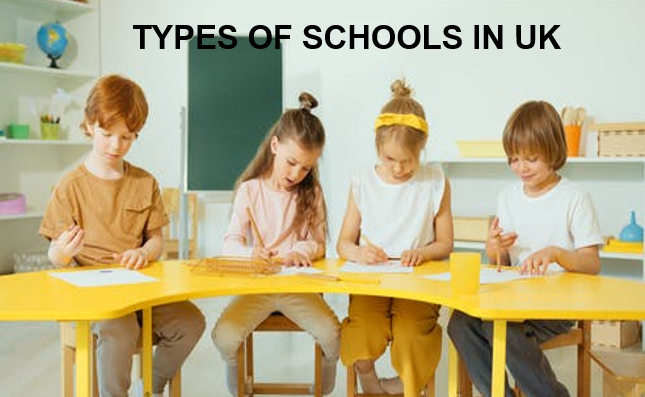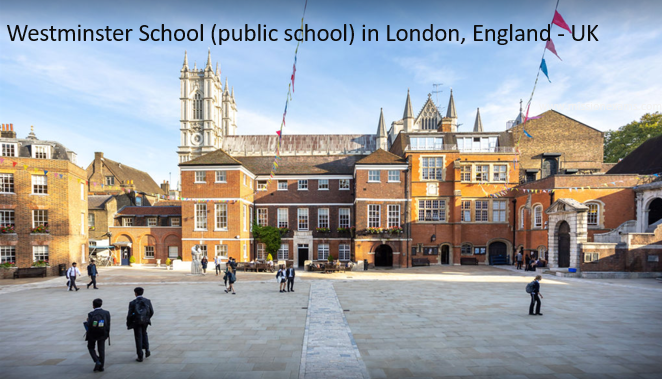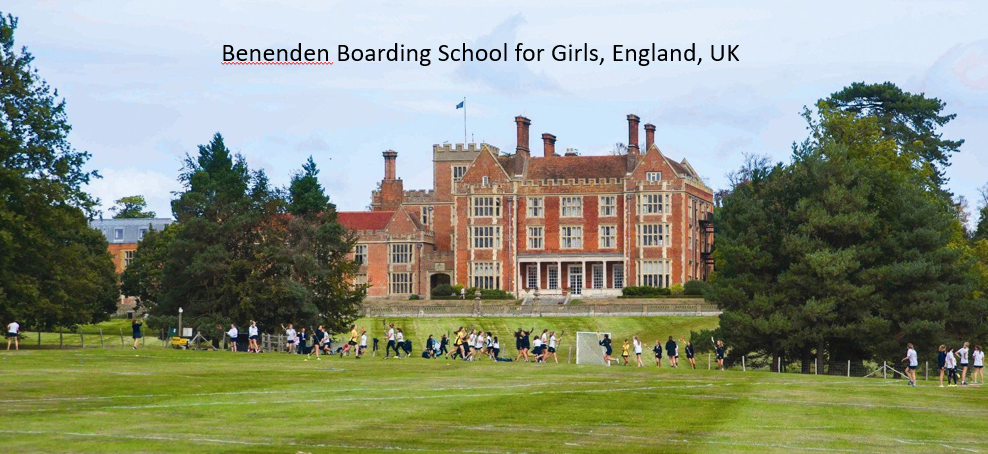Types of Schools in UK with 10 best Public Schools: There are different types of schools in the United Kingdom (UK) with quality education that have existed since ancient times. Most of these schools in the UK are considered the oldest in the world. The main types of schools in the United Kingdom of Great Britain are state schools and private or public schools. In this article, both state and private schools are further classified. We have also explored below which schools in the UK are called public schools or independent schools, about the levels of schools including the 10 best public schools in UK.
Table of Contents

Types of Schools in UK: Introduction
The United Kingdom (UK) of Great Britain is a unitary state consisting of four countries – England, Scotland, Wales, and Northern Ireland. All the four countries of the UK share one monarch, one national parliament and government.. England, Wales, and Scotland are on the same island whereas Northern Ireland is situated on Northern Island. There are different types of schools in the UK..
There is free education with learning concept of school in England for all children between the ages of 5 and 16 years at a state school. The Education Act – 1944 in England and similar Act for Scotland in 1945 provided free secondary education for all pupils of the UK.
Any child residing in the UK and has the right to live (right of abode) in the country may attend their local state school free of cost. Because the UK has a quality state funded school system to provide free education for all. The state types of schools in UK and its education system covers pre-school, primary, and secondary schools for children of age up to 16 years. Let’s start with the types of schools in UK, first state schools in England.
Types of State Schools in UK
The types of state schools in UK receive their funding either through local authority or directly from the government. The types of state schools in UK follow the “National Curriculum” with a set of subjects like English, mathematics, and science prepared by the education department of the UK government. This curriculum is used by state primary and secondary schools. There are different type of state schools the United Kingdom, for example:
- Community Schools: These types of schools are also known as “local authority schools” which follow the national curriculum. The Community schools are not influenced by any interest groups including religious and business groups.
- Foundation Schools and Voluntary Schools: These schools are funded by the local authority but have the freedom in function. They are sometimes also supported by religious groups’ representatives.
- Academies and Free Schools: These types of schools are run by not-for-profit academic trust and independent of local authority interference in their working. Schools are free to follow a different curriculum.. But they are not allowed to use selection processes. These schools are not funded by the local council but directly by the government. These types of schools in UK are allowed to implement their own payroll and terms of conditions for staff. They can also change the length of school sessions or terms and the school days.
Grammar Schools: These schools are run by either the local authority, or a foundation body or an academic trust. These types of schools select their students on the basis of academic ability and through conducting a test for admission.

Above photo source: Courtesy of Dartford Grammar School, England (UK)
- State Boarding Schools: These schools are free or run by local councils. But students are charged for boarding. Schools work and function like academies.
Special Types of Schools in the UK
There are different types of special schools in the UK for education and learning of children who have disabilities of special kinds. As special educational needs and disability (SEND) of children affect their ability to learn in normal schools. Because of their disability,
- They can’t socialise i.e. they struggle in making friends.
- They can’t read and write as a normal child can.
- They are not able to understand things normally.
- Their concentration levels are very poor, and
- In one way or the other they are physically not fit for getting educated in normal school.
Because of the above reasons the special types of schools admit children of age 11 years and above in one of the 4 areas of special educational needs as given below:
- Physical and sensory needs curriculum
- Mental, emotional, and social health
- Communication and interaction
- Cognition and learning
These special schools in the UK are further specialised within their special categories to teach the students who need specific types of care in education and learning. For example, children of autistic spectrum disorders (ASD), visual impairment (weak vision or blind) or students have a disability in speech, language and communication.
Faith schools in UK
Faith schools are one of the types of schools in UK. The association of these schools are with a particular religion. Faith schools in the UK follow the national curriculum except studies of religion. The Faith school can prepare curriculum related to their own religion and teach about without any outside interference. They may have their own admission criteria and staffing policies, although anyone can apply for a place.
Private Schools or Independent Schools in UK
Private types of schools in UK are also called “independent schools’‘ and “public schools”. The private types of schools charge fees from the parents of students who take admission and attend classes. Most of the public schools use entrance exams called “Common Entrance Exams (CEE)” for admission in their schools. The age of children for entrance exams is 11 years for girls and 13 years for boys.

These private types of schools in UK are not funded by the government. Schools as well as Pupils do not have to follow the national curriculum. They are allowed to prepare their own curriculum according to class or grade and follow them. 7 percent of children go to private/independent schools in England.
However, all the private schools in the UK must be registered with the government. Thus, these schools indirectly work under outside control and are inspected regularly by some authorized organisations. These organisations may be “Ofsted”, “Independent Schools Inspectorate” or the “Schools Inspection Service”.
Levels of Schools in UK: Stages of Education
Across the UK there are 3 levels of school education system and 2 levels of education after compulsory period of school education. Thus, there are a total 5 levels or stages of education in UK. These are:
- Pre-school or nursery school
- Primary school
- Secondary school
- Colleges or adult learning institutions (students above 16 years but before universities for degree like courses). This stage is called “Further Education (FE)”.
- Universities for “Higher Education (HE)”.
Here we are going to discuss only 3 stages of education covered by 3 types of schools in the UK.
Pre-schools or Nursery Schools in UK
The Pre-schools or nursery types of schools in UK provide early years education to children of 3 or 4 years of age. For example, in England all children who are 3 and 4 years old are eligible to 15 hours of free early or say nursery education for 38 weeks in a year since 2010. This early years education, also called the “Foundation Phase”, is given either in state nursery schools, nursery classes or reception classes within primary schools. It is also available in privately run nurseries or childminders. Likewise there are Early Years education provisions with some changes in Wales, Scotland, and Northern Ireland.
Primary Schools in UK
The primary schools stage of National Curriculum for education and learning in UK generally cover 3 age ranges:
- Nursery schools under 5 years of age
- Infant or Key Stage-1 schools from 5 to 7 or 8 years of age
- Junior or Key Stage-2 schools up to 11 or 12 years of age
The above classification of school stages vary from state to state. As in Scotland and Northern Ireland there is usually no distinction between Key Stage -1 and Key Stage -2 schools. But, in England, primary schools usually cover children of 4 to 11 years of age.
However, most of the public sector (private) primary schools admit both girls and boys in mixed classes. They generally transfer their students to secondary schools at 11 or 12 years of age. It is 11 years in England, Wales and Northern Ireland but 12 years in Scotland. Thus, in Scotland, children attend primary school a year longer than the rest of the country.
There is another school system in England called Middle Schools. Some children of age ranges between 8 and 14 years choose this middle way of schooling on their own choice. And these middle schools are classified as primary or secondary schools on the basis of the age range of children.
Secondary Schools in UK
The secondary levels of schools in UK generally take the pupils of 11 years old. Whereas in Scotland children’s age of entrance in secondary schools is between 12 and 13 years. In England the secondary education comprises different types of schools including both state (government) and private (public or independent) schools. As comprehensive (state) schools largely take students from neighborhoods without any reference to ability or aptitude tests.
But in some areas the comprehensive schools function along with other types of schools in UK, such as grammar schools, academies, and other independent schools funded by public and private schools.
10 Best Public Schools in UK

ABOVE Photo Source: Courtesy of Benenden School
Any parent thinking of sending their children to the best types of schools in UK can be advised to search about the list given below. The best public schools in UK which are given below have their history in educating the royal families, top politicians, and entrepreneurs.
10 Beat Public Schools in UK
S.N. | Public Schools in UK | Admission | Address | Age | Gender |
1. | Benenden Boarding School | ISEB | Cranbrook TN17 4AA, Kent, England | 11 to 18 | Girls |
2. | Charterhouse School (Boarding & Day) | ISEB | Hurtmore Rd, Godalming GU7 2DX | 13 to 18 | Coed |
3. | Eton College | ISEB | Windsor SL4 6DW | 13 to 18 | Boys |
4. | Gordonstoun School | ISEB | Elgin IV30 5RF, Moray, Scotland | 6 to 12 & 13 to 18 | Coed |
5. | Harrow Boarding School | ISEB | 5 High St, Harrow HA1 3HP, G. London | 13 to 18 | Boys |
6. | The King’s School | ISEB | 25 The Precincts, Canterbury CT1 2ES, Kent, England | 13 to 18 | Coed |
7. | Westminster School | ISEB | 17A Dean’s Yard, London SW1P 3PB, England | 13 to 18 | Coed |
8. | Winchester College | ISEB | College St, Winchester SO23 9NA, England | 13 to 18 | Boys |
9. | Wycombe Abbey School (Boarding & Day) | ISEB | Frances Dove Way, High Wycombe HP11 1PE, England | 11to 18 | Girls |
10. | St Paul’s School | ISEB | Lonsdale Rd, London SW13 9JT, England | 7 to 18 | Boys |
ISEB (Independent Schools Education Board)
Admissions based on: The ISEB Common Pre-tests and school’s pre-test, plus interview and previous school reports.
Curriculum: GCSE (General Certificate of Secondary Education). British students will take their GCSE exams at the end of Year 11 school studies when they are 16 years old.
Direct link to “Types of Schools in UK“
FAQs Related to Types of Schools in UK
Q. How many types of school are there in the UK?
Ans. There are mainly 2 types of schools in UK, the state (government) schools and private (public) schools. The state schools are further of different types, like grammar school, academies, special schools, etc.
Q. What are the different types of school in UK?
Ans. There are different types of schools in UK, for example: faith schools, community schools, foundation schools, grammar schools, free schools or public schools, independent schools, international schools, etc.
Q. What are free schools in UK?
Ans. Free schools in UK are funded by the government but are not controlled by the local authority. These schools have more control over how to manage things like academic selection processes for example, grammar school.
Q. What is high school called in the UK?
Ans. The high schools in the UK are called secondary schools. The term “high school” is used instead of secondary school more frequently in Scotland.
Q. What are community schools in UK?
Ans. The community schools of UK, mainly in England and Wales are funded by state (government) and run by the local education authority. The local authority is responsible for the school’s admissions, and appointment of the school’s staff, and owns the school’s estate.
Q. What are public schools called in UK?
Ans. The public schools in UK are also called independent schools.
Q. What are the main types of schools in the UK?
Ans. The UK features a variety of schools, including state-funded schools, academies, free schools, grammar schools, and independent schools. Each type caters to different educational philosophies and student needs.
Q. How do independent schools differ from state-funded schools?
Ans. Independent schools in the UK are privately funded, providing a unique curriculum and often smaller class sizes. State-funded schools, on the other hand, are funded by the government and follow the national curriculum.
Q. What is the significance of grammar schools in the UK education system?
Ans. Grammar schools in the UK are selective institutions that admit students based on academic merit. They emphasize a rigorous academic curriculum and have been a longstanding feature of the British education system, offering a pathway for academically inclined students.

